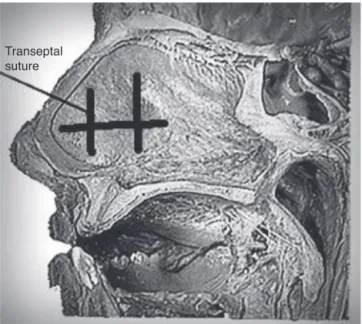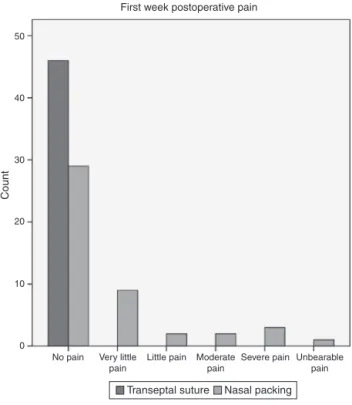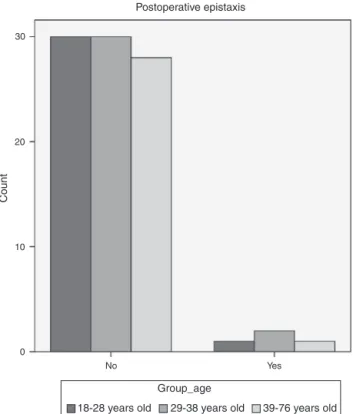BrazJOtorhinolaryngol.2016;82(3):310---313
www.bjorl.org
Brazilian
Journal
of
OTORHINOLARYNGOLOGY
ORIGINAL
ARTICLE
Transeptal
suturing
---
a
cost-efficient
alternative
for
nasal
packing
in
septal
surgery
夽
Daniel
Pérez
Plasencia
a,
Juan
Carlos
Falcón
a,
Silvia
Borkoski
Barreiro
a,∗,
María
Sacramento
Bocanegra-Pérez
b,
Mario
Vicente
Barrero
b,
Ángel
Ramos
Macías
aaHeadNeckSurgDepartment,ComplejoHospitalarioUniversitarioInsular-MaternoInfantil,GranCanaria,Spain bStomatologyDepartment,ComplejoHospitalarioUniversitarioInsular-MaternoInfantil,GranCanaria,Spain
Received7February2015;accepted12May2015 Availableonline6November2015
KEYWORDS
Septalsurgery; Nasalpacking; Transeptalsuture; Efficiency
Abstract
Introduction:Nasal packing is routinely used in septal surgery to prevent postoperative bleeding.
Objective:Todemonstratethepossibilityoftranseptalsutureasasafeandeffectivewayto avoidnasalpackingandtoimproveefficiency.
Methods:Thisisaprospective,descriptive,inferentialcoststudycomprising92patients.Two randomized groups of patients were analyzed, one with nasal packing and the other with transeptalsuture.
Results:Inthegroupoftranseptalsuturenopatientexperiencedpostoperativebleeding,and astatisticallysignificantreductionofpainandheadachewasdemonstrated.Atthesametime, weimprovedefficiencybysavingonmaterialcosts.
Conclusions:Transeptalsutureisaneffectiveandsafealternativetoclassicnasalpackingin septalsurgery.Moreover,itimprovestheefficiencyoftheinterventionbysavingcosts. © 2015Associac¸˜ao Brasileira de Otorrinolaringologiae CirurgiaC´ervico-Facial. Publishedby ElsevierEditoraLtda.Allrightsreserved.
PALAVRAS-CHAVE
Cirurgiaseptal; Tamponamentonasal; Suturatranseptal; Eficiência
Suturatranseptal---umaalternativacusto-benefícioparatamponamentonasal emcirurgiadosepto
Resumo
Introduc¸ão:Otamponamentonasaléusadorotineiramentenacirurgiaseptalparaevitar san-gramentosnopós-operatório.
夽
Pleasecitethisarticleas:PlasenciaDP,FalcónJC,BarreiroSB,Bocanegra-PérezMS,BarreroMV,MacíasAR.Transeptalsuturing---a
cost-efficientalternativefornasalpackinginseptalsurgery.BrazJOtorhinolaryngol.2016;82:310---3.
∗Correspondingauthor.
E-mail:silviaborkoski@hotmail.com(S.B.Barreiro).
http://dx.doi.org/10.1016/j.bjorl.2015.05.016
Transeptalsuturingisacost-efficientalternativeinseptalsurgery 311
Objetivo: Demonstrarapossibilidadede serealizarumasuturatranseptalcomo alternativa eficazeseguraaotamponamentonasal,commelhoranaeficiênciadaintervenc¸ão.
Método: Esteéumestudoprospectivo,descritivoedecustoinferencial,compreendendo92 pacientes.Doisgruposaleatóriosforamestudados:umcomtamponamentonasaleooutrocom suturatranseptal.
Resultado: Nogrupodesuturatranseptal,nenhumpacienteexperimentousangramentono pós-operatório,tendosidoestatisticamentedemonstradaumasignificantereduc¸ãodecefaléiae dor.Aomesmotempo,houvemelhoranaeficiênciadaintervenc¸ão,comeconomianocustode material.
Conclusões: Asuturatranseptaléumaalternativaeficazeseguraaotamponamentonasal clás-sico.Alémdomais,melhoraaeficiênciadaintervenc¸ão,economizandonocustodematerial. ©2015Associac¸˜ao BrasileiradeOtorrinolaringologiaeCirurgiaC´ervico-Facial.Publicado por ElsevierEditoraLtda.Todososdireitosreservados.
Introduction
Septalsurgeryisoneofthemostfrequentlyperformed pro-ceduresinrhinology.Postoperativenasalpackinghasbeen thefinalstepinthisproceduresinceitsearlydescriptions.1 Thepurposeofnasalpackingistoavoidbleedingorseptal hematoma,reduceedema,optimizethepositionofthe sep-talflaps,closethedeadspace,provideinternalsupportand preventdisplacementofthecartilage.2However,these con-siderationsarenotsupportedinstudieswithlargenumbers ofcases.3
Ontheotherhand,thereisnoconsensusonitsduration, rangingfromlessthan24htomorethanaweek.Moreover, performinganasalpackinginvolvesacertainrisk,andithas beenassociatedwithcardiovascularchanges,nasaldamage, hypoxemia,apnea,ototubaritis,otitismediaand hemotym-panum, foreign-body reactions, infections and even toxic shocksyndrome(amongothers).Themostcommonpatient complaintsarediscomfort,painandnasovagalreflexes at themomentofwithdrawalofthepacking.
Lemmenswrotethatthesearchforalternativesstarted withLee,whodescribescontinuousseptalsutureasan alter-nativeoptiontonasalpacking.4
Methods
We studied a group of 92 patients whounderwent septal surgerybetweenJanuary2008andJanuary2013(5years).
Themainandcompulsoryinclusioncriterionforthestudy waspatients with respiratory unilateral or bilateral nasal distressthatwerefoundwithseptaldysmorphia.Allpatients signedaninformedconsentpriortosurgery.
Exclusioncriteriawerepatientswithchronic rhinosinusi-tis with nasal polyposis, patients with HIV infection and immunosuppressed patients, in orderto avoid bias in the study.
Allprocedureswereperformedundergeneralanesthesia with laryngeal mask. The nose was systematically anes-thetizedwithtopicaltetracaine(10mg/mLwithadrenaline 1%)instilledwithcotton wicks,andlocalanesthetic (0.5% bupivacainewithepinephrine1:200,000)wasinfiltratedin
theseptalmucosasubperichondriallyonboth sidesofthe septum.
The incision was always hemitransfixional, the mucoperiosteal---mucoperichondrium was elevated bilat-erally and the deviated bone and cartilaginous part of theseptum weretakenoff. Aftercorrectingthe deviated structures,theincisionwasclosedwithVicrylTM3/0.
Thedistributionofpatientsinthetwostudygroupswas randomized(bysealedenvelope).Theyweregivenanasal packing withpolyvinyl alcohol sponge(MerocelTM) or 2---3
transfixingsuturestitcheswithVicrylTM3/0usingacurved
needlewithat least oneor twoverticalstitches andone horizontalstitch,therebyapproximatingtheflapofmucous membraneandavoidingdeadspaces(Fig.1).
All procedures were performed in the afternoon, and patients were hospitalized until the next morning. This periodlastedabout16honaverage(range14---19).
Theywere subsequently checkedthreeandseven days aftersurgery. Duringthefirstvisit,wewithdrewthenasal
Transeptal suture
312 PlasenciaDPetal.
polyvinylalcoholspongesinthegroupofpatientswithnasal packing.All patients wererequired torank postoperative painexperiencedusingavisualscaleofpainintensity clas-sifiedinarangefrom1to5.Thisscaleisbasedonthefacial affective scale.5 Then, the patients were checked every monthfor threemonthstoassess progressin themedium term.
Univariate comparisons of outcome between the two groups were made with 2 analysis, Fisher’s exact test, and t-tests. We used IBM SPSS Statistics Desktop v. 21.0 SoftwareTM.
Surgical procedures were done in two private medi-cal centers without scientific ethic medical committee. Informedconsentwassignedforeverypatient.
Results
Ninety-twoseptoplastiesdonefromJanuary2008toJanuary 2013wereincludedinthisstudy.Thepatientsweredivided intwogroups(packingortrans-septalsuture)of46patients each.
The sex distribution of patients was 53 men and 39 women,andthemeanagewas32.12yearswithamedian of47years(range18---76).Therewerenosignificant differ-encesbetweenthetwopatientgroups.
All patients had preoperative nasal symptoms such as respiratoryfailure(100%).Otherassociatedsymptomswere rhinorrhea(52.85%),sneezing(45.71%),hyposmia(35.71%) and self-limited epistaxis (17.14%). In rhinoscopy septal deviation was observed in 100% of cases, and inferior turbinate hypertrophy in 71.42% of cases. There were no significantdifferencesinthesepreoperativesymptomsand signsbetweenthetwopatientgroupsstudied.
Mean surgery time was 32min (range14---50), with no significantstatisticaldifferencesbetweengroups.
We studied postoperativepainduring the firstweek in both groups. We have obtained significant differences in favor of thegroup undergoing trans-septal suture.In this grouponlyonepatienthadseverepaincomparedto11in thenasalpackinggroup(p<0.01)(Fig.2).
Wheninterrogatedregardingtheexistenceofheadaches after surgery we observed again significant differences. Thegroupofpatientsundergoingnasalpackinghadhigher headacheincidence(p<0.01)(Fig.3).
In the group of patients with trans-septal suture, the main complications were septal abscess and septal hematoma. In the group of patients with classic packing nonereportedsuchcomplications.Wefound nosignificant differencesbetweenthetwogroups.
Inthelastvisits(3months),thepercentageofpatients withnasalrespiratorydistresswas6.5%inthetrans-septal suturegroupand23.9%inthegroupwithpacking,withno significantdifferences.
Inthetrans-septalsuturegroupweobservedno signifi-cantepistaxis.Inthegroupofnasalpacking4patientsdid reportepistaxisjustafterremoval(8.69%),butnonehadto usethemagain.Thedifferencewassignificantinthiscase (p<0.05)(Fig.4).
One month after surgery 91.31% of patients were sat-isfiedwiththeoutcome ofthesurgery, withnosignificant differencesbetweenthetwosurgicalprocedures.
0 10 20 30 40 50
Count
No pain Very little pain
Little pain
First week postoperative pain
Severe pain Unbearable pain Moderate
pain
Transeptal suture Nasal packing
Figure2 Firstweekpostoperativepain.
Inthecoststudy,weemphasizethesavingsderivedfrom avoiding bilateral nasal packing.The costof each unit of nasalpackinginourcenteriscurrently19.5euros, exclud-ingtaxes.Inusingthisalternativeprocedure,wehavesaved 1794 euros excluding taxes, thereby increasing the effi-ciencyoftheprocess,sinceothercostsaresimilarforboth techniques.
10 20 30 40 50
Count
No pain Very little pain
Little pain
First week postoperative headache
Severe pain Unbearable pain Moderate
pain
Transeptal suture Nasal packing
0
Transeptalsuturingisacost-efficientalternativeinseptalsurgery 313
30
20
10
0
No
Postoperative epistaxis
Group_age
18-28 years old 29-38 years old 39-76 years old
Count
Yes
Figure4 Postoperativeepistaxis.
Discussion
Thisstudyaimstoverifytheusefulnessofnasaltrans-septal suturetoavoidnasalpackingandtoimprovecostefficiency ofthesurgicalprocedure.
Tothisend,wecollecteddatafromeachpatient’s medi-calhistory.Inaddition,wecollectedtheresultsbypatients inthefirstcheck,wheretheywereaskedtochooseavalue from a visual pain scale rating based on facial affective scale.5
Themaincomplaintofpatientsisthepainanddiscomfort relatedtotheremovalofnasalpacking.6
The objectiveofnasalpackingistodiminishthe likeli-hoodof postoperativebleedingbut,asseen inourseries, none of the nasal packing patients had 0% postoperative bleeding,andinfact,4patientsreportedsignificant bleed-ingafterremovalofthepacking,althoughnonehadtouse themagain.Thisagreeswiththedataobtainedinthe meta-analysisbyCertaletal.,7whichconcludesthatpatientswith nasalpackinghaveareducedriskofpostoperative hemor-rhageof1%,whichisnotsignificantfromastatisticalpoint ofview.Norshouldoneforgetthatafterthewithdrawalof classicpacking,thereexiststhepossibilityofhavingtodo thepackingagain,asbleedingmayoccur.4Anotherobjective of the packing is to stabilize parts of the septum carti-lageandbone.Thisstabilizationcanalsobeachievedwith the trans-septal suture structures,which can also remain stablefora muchlongertime,depending onthe material used.2
All studies reviewed conclude that patients suffer less painanddiscomfortifnonasalpacking(1---4,6---7)isused. Thedifferenceisstatisticallysignificantandismostevident inthecaseofheadaches,whicharereducedby57%if trans-septalsutureisperformed.7Thesedataareconsistentwith thoseobtainedinthisstudy.
Withregardtoseptalhematoma,studiesthatcollectthis datadonotshow significantdifferences betweenthe two techniques.7 We have seen 2 cases, one of which was a complicatedonewithseptalabscess.Again,nosignificant differenceswerefoundbetweenthetwogroups.Inorderto avoidtheseproblems,werecommendmakingsomeincisions inseptalmucosaasdrainage.
To all the advantages listed above, we shouldadd the reduction in costs derived from the use of packing. The trans-septal suture is made with the same material used inthehemitransfixionincisionsutureanddoes notinvolve increasingthecostofconsumables,nordoesitincreasethe durationoftheprocedure.
Conclusions
Most surgeons still use nasal packing following septal surgery. This work aims only to draw attention to the possibility of avoiding nasal packing, thereby improving postoperativepatientsandprocessefficiency.
Funding
Thisworkhasnotbeenfundedbyanypublicorprivate com-pany.
Conflicts
of
interest
Theauthorsdeclarenoconflictsofinterest.
References
1.DubinMR,PletcherSD.Postoperativepackingafterseptoplasty: isitnecessary?OtolaryngolClinNorthAm.2009;42:279---85.
2.Reiter D, Alford E, Jabourian Z. Alternatives to pack-ing in septorhinoplasty. Arch Otolaryngol Head Neck Surg. 1989;115:1203---5.
3.JosephT,MarksNJ.Submucousresectionasanoutpatient pro-cedure.JLaryngolOtol.1991;105:877.
4.Lemmens W, Lemkens P. Septal suturing following nasal septoplasty,avalidalternativefor nasalpacking?Acta Otorhi-nolaryngolBelg.2001;55:215---21.
5.Astudillo W, Mendinueta C, AstudilloE, Gabilondo S. Princip-iosbásicos paraelcontrol deldolortotal.RevSoc EspDolor. 1999;6:29---40.
6.Yilmazer C,Sener M, Yilmaz I,Erkan AN, Cagici CA, Donmez A, et al. Pre-emptiveanalgesia for removal ofnasal packing: a double-blind placebo controlled study. Auris Nasus Larynx. 2007;34:471---5.


